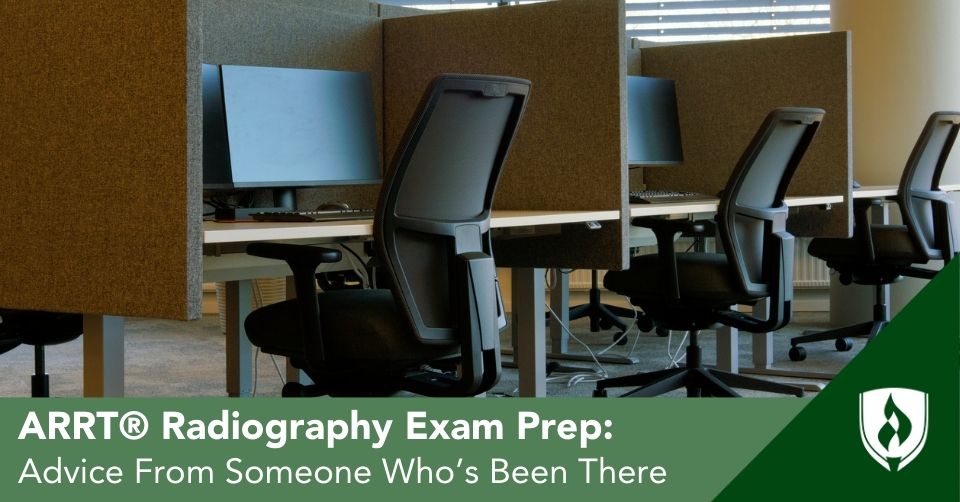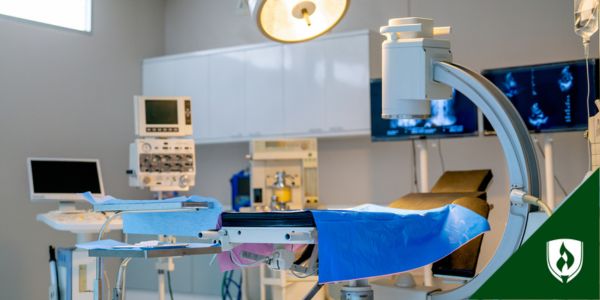
So, you’ve worked through your radiologic technology (rad tech) program. Congratulations! You are so close to starting your rad tech career.
Now, you just need to obtain your American Registry of Radiologic Technologists® (ARRT®) certification.
“When I was taking my boards exam, I was so nervous!” says Jessica Skogen-Griffin, ARRT, RT(R), program coordinator with the Radiology Technology Department at Rasmussen University.
“It was finally time to see how my two-year adventure could become my career."
The primary eligibility pathway for this radiography examination involves earning an associate's degree in radiologic technology at an ARRT-recognized institution, a process that can be completed in as few as 24 months.1
Once you graduate, it’s time to put all that preparation to the test. Literally.
The primary ARRT radiography exam includes multiple types of diagnostic imaging and proves that you have met the educational and professional standards in medical imaging, magnetic resonance imaging, sonography, nuclear medicine technology sonography, radiation physics and what a rad tech needs to know about interventional procedures, patient care and image production.2
Once certified, you’ll be able to apply for positions as a radiologic technologist with “RT(R)” after your name.
But, to pass this radiography examination, you must be prepared—this isn’t a test you cram for in one long weekend.
Tips to Pass Your ARRT Exam
We asked a rad tech, instructor and radiologic technology program coordinator to share about the ARRT exam prep tips that make the biggest difference. Here’s what she shared.
Review all your notes
“The biggest challenge in preparing for the ARRT board exam is sufficiently reviewing materials throughout the program,” Skogen-Griffin says.
“I see many students in their capstone courses who do not go back to day one of the program and review throughout each quarter on previous materials.” Skogen-Griffen says this makes the depth of the capstone work feel more overwhelming than it needs to.
“The ARRT board exam is based on cumulative and comprehensive understanding of all materials taught throughout the program.” Your first quarter of learning might feel a million miles away at this point—but go back and review your notes.
Study in blocks, spread out over a week
One interesting feature of the ARRT exam is the way it covers several different categories of information. You can use that to your advantage for memory retention.
Dedicate 2-3 hours per day (over a weeklong period or longer) and choose a few categories to study for each block, advises Skogen-Griffin.
“Dedicating each day to a new category will provide structure in your material and adequate time to reflect and absorb the information,” she says.
Take advantage of physical spaces
“I believe the more we can see the information, the more we will be able to retain it,” Skogen-Griffin says. Use spatial memory tricks like doing each block/day/category of study in a different physical space.
For example, it might help on the exam if you can remember studying breast sonography and cardiac interventional radiography in the kitchen and nuclear medicine technology at the library.
Also, post notes around with the especially tricky things you need to memorize, Skogen-Griffin says. “Put a note on your mirror so you see the information when getting ready, for example.”
Understand the ARRT test format
The radiography registry exam is a computer-based test that starts with a tutorial and practice questions to get you used to the format. But you don’t have to wait for test day to get used to that.
The test has 230 questions, including standard multiple choice, negatively worded and illustration questions. Thirty of those questions are pilot questions that aren’t graded.3
The scheduled exam time depends on your field of study. The duration corresponds with the number of scored and non-scored questions for your discipline. This also considers the time it takes to complete the tutorial, NDA and survey—total actual exam time could exceed four hours.
Everything the ARRT provides about their exam, from eligibility requirements to making testing appointments and requesting accommodations can be found in their Primary Eligibility Pathway Handbook.
Take practice tests
Practice, practice, practice! Once you feel ready, it’s time to boost your confidence and test your knowledge!
Practice tests, quizzes and practice questions can help you become familiar with the test format, identify your weak areas and feel more confident on test day. Practice tests may include real questions from the exam and offer detailed feedback along with the correct answers.
If you haven’t already joined a rad tech association or society—now might be the time!
“ The American Society of Radiologic Technologists® (ASRT®) and state societies often have wonderful student membership options that can provide board materials and even mock exams,” Skogen-Griffin says. These hubs of information and networking can also be useful for your job search once the exam is under your belt.
“Corectec®, Mosby’s®, radiography prep and so many other alternative review options are available for students,” Skogen-Griffin says. “It can be beneficial to utilize a variety of sources in preparation for the boards exam as it has the potential to change verbiage or add more in-depth explanations of specific content.”
Download and review exam content specifications
The exam is designed to test knowledge and cognitive skills that are essential for entry-level technologists to ensure safety and perform their duties successfully.
The content categories are listed below, guided by the exam content specifications.3
- Bone Densitometry
- Breast Sonography
- Cardiac Interventional Radiography
- Computed Tomography
- Magnetic Resonance Imaging
- Mammography
- Nuclear Medicine Technology
- Radiation Therapy
- Radiography
- Registered Radiologist Assistant
- Sonography
- Vascular Interventional Radiography
- Vascular Sonography
The ARRT website has PDF files under each of those topic areas with outlines of the content you’ll need to know.
“Download and review that ARRT board breakdown,” Skogen-Griffin says. “Use it as a programmatic study guide. It is broken into categorical breakdowns for each specification, positioning and protocol. It is a wonderful tool!” You can then research detailed explanations for anything you are having trouble with.
Spend more time with what you don’t really understand
While studying for the exam, first identify the content areas you understand best and the ones that might require additional study time.
“Focus on the weak points,” Skogen-Griffin says. If you already understand something, don’t spend time on it. “If you study the things, you already know, you won’t be able to retain what you don’t.”
Ask for help from instructors and peers
Whether it’s a mentor, an instructor, someone who’s already passed the exam or a study buddy, it’s ideal to request help and schedule study time together!
“I did not have the involvement of instructors and coordinators through my educational program when I was a student,” Skogen-Griffin says. “I was left feeling alone for a lot of the program and had to teach myself some things post-graduation.” Without reinforcement and guidance from others, the path to become a rad tech was harder than it needed to be.
“At Rasmussen University, our program has all entities so involved in the student’s work,” Skogen-Griffin says. “I am so grateful that they get to have this experience and guidance.”
Get some space
Pay attention to when your brain is no longer retaining information. Take breaks. There’s no point in trying to force yourself through material when you just can’t absorb it anymore.
“Allow ME time,” Skogen-Griffin says. “There is such a thing as overstudying which can lead to confusion or overwhelming emotions. Our brains need time to rest and absorb the information we learned.”
Review what testing day will look like
PearsonVUE® provides the computer-based testing services for this exam.
Before you schedule the appointment, you must create an account, pay the exam fees and receive your Candidate Status Report (CSR). Once you've scheduled the exam, you’ll receive confirmation with the date and time, address, phone number and directions to your testing location.
“To say the check-in at Pearson Vue is thorough would-be an understatement,” Skogen-Griffin laughs. It’s a lot. And it can cause you more anxiety if you expect to just walk up to a computer and get going.
The ARRT handbook details the full-check in experience (starting on page 40) but some basic things to know are...
- Arrive 30 minutes early.
- You need to bring your approved I.D. and any documentation related to ADA testing accommodations.
- You will be sharing the center with other test-takers (and not all taking the ARRT exam).
- You can request earplugs or noise reduction headphones before the exam.
- There’s no space for people to wait for you in the testing center.
- You can’t wear a jacket or head coverings like hats or hoods, but you can wear a head covering for cultural or medical reasons.
- You will have to empty your pockets and leave all personal items in a locker, including your phone.
- They will scan your palm before you begin (and if you need to leave/return at any point to use the bathroom).
- Your workstation time will begin with an optional, but highly-recommended, tutorial.
- Right before the test, you have to sign a Non-Disclosure Agreement (NDA). If you don’t, your appointment will end, and you’ll have to reschedule the exam.
- You must remain in your seat for the entire exam unless you raise your hand and receive permission to take a short break (under ten minutes).
Trust your first instinct on exam questions
It’s easy to get overwhelmed with exams like this. Skogen-Griffin describes herself as an anxious test-taker. “I have the tendency to second guess myself, which led me to change correct answers. It has been something I have had to work on throughout my life.”
“I tell my current students all the time, ‘Do not be me! Try not to go back to a question unless you 100% do not know it because, more than likely, your subconscious is telling you the answer,’” Skogen-Griffin says. “Go with your subconscious, go with your gut!”
Know what to expect from the ARRT exam scoring
The exam uses a scaled scoring system that ranges from 1 to 99—you’ll need a total score of 75 or above to pass.4
The number of correct answers required to reach a score of 75 will vary since different exam versions have different numbers of questions, sections and difficulty levels.
When you finish the exam, you’ll see a preliminary score, which is not the final score. (Your official score report will be mailed to you within three weeks). But it is enough to go on.
When Skogen-Griffin saw that she'd passed her exam, she felt pure elation. "The feeling was unlike any other feeling I have had before! I was so grateful and proud of myself," she remembers.
"I had a challenging time remaining composed until I reached my vehicle, I just wanted to cry happy tears and scream at the top of my lungs! It was a relief, it was dignity, it was challenging work, it was success!"
Preparing for the ARRT Exam: You've got this
This career offers so many advantages--job security, career advancement and specialization opportunities and most of all the chance to help people. This can be such a rewarding career for anyone who wants to work with their hands and maybe make someone's life a little brighter via amazing patient interactions.
You’re making a difference in people’s lives... and that’s worth it. It's worth the work you've put in, and the feeling you'll have when you succeed is amazing. Now, get to it!
And if you're ready to start thinking about your first day on the job, check out What They Don't Tell You in the Radiologic Technologist Job Description.
ARRT® is a registered trademark of the American Registry of Radiologic Technologists®
ARST® is a registered trademark of the American Registry of Radiologic Technologists®
PearsonVUE is a registered trademark of NCS, Pearson Inc.
Corectec is a registered trademark of Corectec Inc.
Mosby’s is a registered trademark of Elsevier Health
American Registry of Radiologic Technologists® is a registered trademark of The American Registry of Radiologic Technologists
1Completion time is dependent on the number of transfer credits accepted and the number of courses completed each term.
2INITIAL REQUIREMENTS FOR EARNING ARRT CREDENTIALS, ARRT.org (accessed April, 2025). https://www.arrt.org/pages/earn-arrt-credentials/requirements
3Preparing for your Exam, ARRT.org (accessed April, 2025) https://www.arrt.org/pages/earn-arrt-credentials/initial-requirements/exam/preparing-for-your-exam
4Exam Scoring, ARRT (accessed April, 2025) https://www.arrt.org/pages/earn-arrt-credentials/initial-requirements/exam/after-the-exam/exam-scoring




